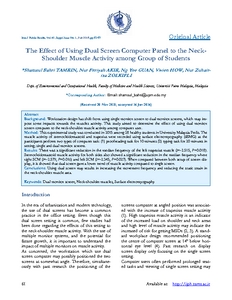Citation
Mohd Tamrin, Shamsul Bahri and Akir, Nur Fitriyah and Ng, Yee Guan and How, Vivien and Zolkifli, Nur Zuhairiza
(2016)
The effect of using dual screen computer panel to the neck-shoulder muscle activity among group of students.
Iranian Journal of Public Health, 45 (1).
pp. 61-67.
ISSN 2251-6085; ESSN: 2251-6093
Abstract
Background: Workstation design has shift from using single monitor screen to dual monitor screens, which may impose some impacts towards the muscles activity. This study aimed to determine the effect of using dual monitor screen computer to the neck-shoulder muscle activity among computer user.
Method: This experimental study was conducted in 2015 among 28 healthy students in University Malaysia Perlis. The muscle activity of sternocleidomastoid and trapezius were recorded using surface electromyography (sEMG) as the participants perform two types of computer task: (1) proofreading task for 10 minutes (2) typing task for 20 minutes in setting; single and dual monitor screens.
Results: There was a significant reduction in the median frequency of the left trapezius muscle (t=-2.515, P=0.018). Sternocleidomastoid muscle activity for both sides also showed a significant reduction in the median frequency where right SCM (t=-2.579, P=0.016) and left SCM (t=-2.345, P=0.027). When compared between both setup of screen display, it is showed that dual screen gave a lower trend of muscle activity compared to single screen.
Conclusions: Using dual screen may results in increasing the movement frequency and reducing the static strain in the neck-shoulder muscle area.
Download File
![[img]](http://psasir.upm.edu.my/55570/1.hassmallThumbnailVersion/The%20Effect%20of%20Using%20Dual%20Screen%20Computer%20Panel%20to%20the%20Neck-Shoulder%20Muscle%20Activity%20among%20Group%20of%20Students.pdf)  Preview |
|
PDF
The Effect of Using Dual Screen Computer Panel to the Neck-Shoulder Muscle Activity among Group of Students.pdf
Download (267kB)
| Preview
|
|
Additional Metadata
Actions (login required)
 |
View Item |

